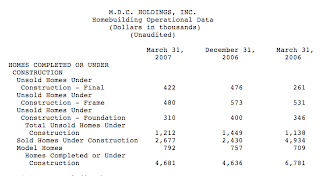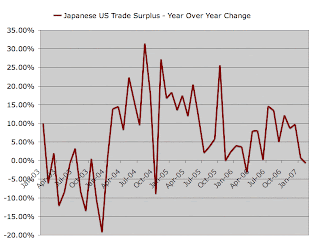Hedge Fund Borrowing Propping Up the Dollar and Stock MarketYesterday I read an
article listing the 10 highest paid hedge fund managers in 2006. Topping the list for the second year in a row was
James Simons (go bears!), so naturally I wanted to find out
what I could about how his hedge funds make their profits.
According to the article, "the hedge fund firm employs roughly 80 PhD's who develop computer programs to seek out price anomalies in a wide range of markets, including equities, commodities, futures and options." I don't have any insights into what Renaissance is doing in the commodities futures and options markets, but at least in terms of equity holdings, the record is pretty clear. The fund began buying aggressively in Q3 2005 and got more aggressive each quarter, almost tripling their equity holdings during 2006:

Before fees, Renaissance's Medalion fund earned a return of 79% (44% after fees). With the stock market up just 15% last year and Renaissance's holdings spread out among almost 3,000 different equities, it's safe to assume that a large amount of leverage was employed to boost the return numbers. Most likely the Fund borrowed Yen during 2005 and 2006 and used these funds to buy dollars and then US equities and other investments. With the Yen down against the dollar over the past two years, highly leveraged borrowings would have greatly increaed the overall returns. Of course a falling dollar and/or a falling stock market would have led to magnified losses, rather than magnified gains.
The biggest spike in buying came during Q4 last year, and the holdings numbers are still fresh, showing which positions were added to and which were reduced. One thing that jumped out at me was that the 4 stocks where the most new capital was directed were all Dow Industrials:

The three stocks getting the most new capital on average accounted for more than triple what other top investments received. Dow Stocks also made up 3 of the top five on the sell side. In all, a net of $2.5 billion was poured into Dow Industrials by Renaissance during the last quarter of the year. This likely helped boost the Dow, as the total index was up 6.71% during the quarter, while the 10 Dow stocks purchased by Renaissance rose a weighted average of 8.11% and the 6 stocks sold only rose a weighted 6.33%. Interestingly, the Dow stocks with shares bought by Renaissance in Q4 were poor performers in Q1 2007 (falling 1.85%) when compared to the good performance of their recent sells (+1.30%), implying that they really weren''t good stock pickers.
When the 80 PhDs go looking for "inefficiencies" I don't get the impression they are doing much analysis of value in a traditional sense. It is noted that Simons hires mathematicians, rather than MBAs, so the soundness of a companies business model and it's future projected earnings are not likely to be a big factor in the computer driven trading strategies. In looking at the stocks where they took on a position of over 5%, there were plenty of stocks with negative earnings per share and high price to book values:

While I believe the 80 PhDs are extremely good at creating successful computer models and trading strategies, I don't need a PhD or a sopisticated computer to figure out what are likely to be the main underlying secrets to their success. The biggest and most lucrative inefficiences to exploit are technical in nature (rather than fundamental). The computer models are probably especially good at detecting when too many people have shorted a stock or when to arbitrage profits out the greedy short term bets options traders like to make. Prices can be manipulated for short term gains or they can simply be driven up almost endlessly for positions the company already holds. The following table shows the date when Renaissance reported going over the 5% ownership threshold for stocks (prior to the start of Q4), and then includes the number of shares added during Q4, presumably boosting the net asset values of the fund:

The next table shows the increasing number of new positions that went past 5% during Q4:

Buying up a large enough number of shares in a stock can drive up the price. We can be sure the programs have concluded that thiswill improve their performance, but given the complexity of the programs involved we can't be sure if the people behind the programs really understand the difficulty of reversing course when the fundamentals of a company or the market deteriorate. The chart of Renaissance's total equity investment over time has the look of a system out of control. It is probably indicative of the our whole financial system, dependent on ever higher rates of borrowing and credit expansion until the day when finally credit from abroad is cut off. Perhaps Simons is already well aware of this and sees no choice but to head forward at full steam.
I don't think "inefficiencies in the markets" is as good a description as "flaws in the system" when it comes to describing the success of computer trading models in generating high returns for hedge fund managers. In my opinion, the stocks Simon's holding are valued less efficiently as a result of his actions rather than more efficiently. Also, in my view, the market as a whole is driven higher through the leverage he and other hedge funds employ, while long term economic instability they are creating should be pointing toward lower valuations.
In an abstract, disconnected kind of way, the computer models probably account for the basic conflict of interests in the hedge fund compensation model: Heads we both win, tails you lose. If the models seek to maximize gain for the hedge fund managers, then they will seek to elevate risk to a very high threshold. While the fund has a track record of earning 36% per year for almost 2 decades, one year of 100% losses would of course negate that for anyone who let their profits ride or came late to the party. I could concoct a scheme to guarantee 50% returns on aveage. Three years of 100% gains, followed by one 100% loss equates to an average return of 50%, but a net loss of -100% for the investor. Meanwhile, I as manager would be syphoning out my 20+% per year before blowing all the rest of the investors money in the final year. If I programmed a computer to simply maximize my projected gains as the manager, an extremely high risk strategy would be the result.
Renaissance is taking on a very high degree of risk. With over $47 billion leveraged into the stock market, they won't have a fun time trying to get out once the market finanally turns ugly. How deeply the bias toward risk is represented in the core mathematical models is a question for the PhDs. Simons has reportedly collected around $3.2 billion in compensation during the last 2 years alone. When most people see those kind of numbers the reaction is that nobody could possibly deserve to make that much money. In my view, Simons has created a brilliant business model that takes advantage of flaws in the system. To the extent that he is profiting from the mistakes of other traders there is no real harm done to the economy. Indeed Simons has done a lot of good through his charitable contributions. However, to the extent that Renaissance is creating systemic risk by (possibly) playing the Yen Carry Trade, creating excess liquidity and promoting malinvestment Simons may be doing substantial economic damage to this country and the world.
The thing I'll be most intersted in watching is wether Renaissance has the ability or desire to reduce its risk exposure before it is too late of if they'll just continue taking on more risk until the system reaches its final limits. Hopefully I'll find some more clues to this in the Q1 holdings report they'll release in May.
Labels: Renaissance Technologies James Simons

























